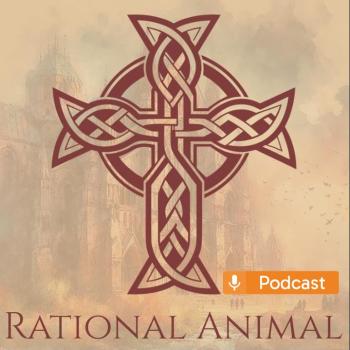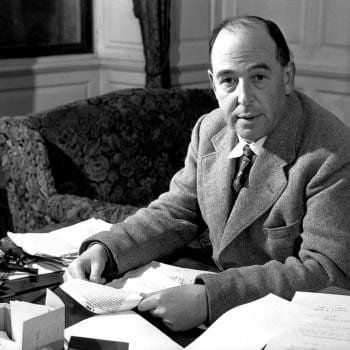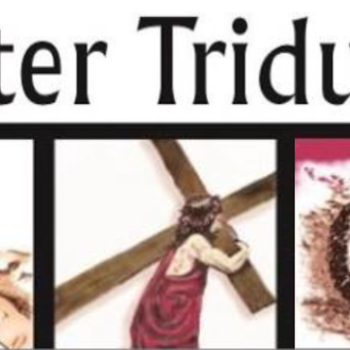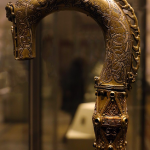Stories from the Magazine of the Catholic University of America
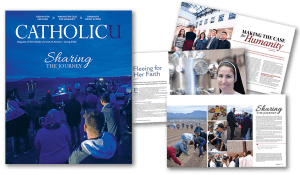
My copy of “Catholic,” the Magazine of The Catholic University of America arrived. This spring issue had a theme, and I found much more to read than usual. The theme was immigrants in the U.S. and university and student activism in that area. University president John Garvey’s lead-off essay told me something I never would have guessed. The first DREAM Act, in 2001, was introduced in Congress by Utah Republican Senator Orrin Hatch. I must have known it at the time, but subsequent trends in Republican Party politics drove it from my mind. Not for the first time I’m wondering what has happened to the Republican Party.
DREAM is an acronym for “Development, Relief, and Education for Alien Minors.” DREAMers, immigrants who came to the United States before their 18th birthday, number in excess of 3.6 million. There have been ten versions of the DREAM Act. Its provisions have widespread popular and bipartisan support. But the act has never made it into law largely because of opposition by Republican Members of Congress.
DACA, Deferred Action for Childhood Arrivals, was President Obama’s end run around the legislative roadblock. This act protected those who applied from deportation for two years. It allowed 800,000 participants to work legally and obtain driver’s licenses. Garvey says, “Though not perfect, it was a welcome relief for those who qualified. A small dream come true.” And that small dream is now in trouble in Donald Trump’s presidency.
Bigger than DREAM
DACA participants are only 22 percent of the number of arrivals that would be eligible under DREAM. And they represent only 33 percent of 11.3 million undocumented immigrants in the country. Garvey writes:
The Catholic University of America supports DACA students, and it supports the DREAM Act, but it is also committed to a much bigger dream. In his message for the 2019 World Day of Migrants and Refugees, Pope Francis reminded us that immigration isn’t ‘just about migrants. It is about our humanity.’
One professor pursuing the larger dream is William Dinges, in the School of Theology and Religious Studies. Interested in history of religion in America, he teaches courses on immigration issues. “One could hardly talk about any aspect of the American experience without touching on immigration,” he says. Climate change is a driver of immigration, Dinges says, and it’s going to get worse. Because of climate change and our historical destabilizing role in Central America, foreign aid to these countries must be part of our response to immigration. It will go farther than building walls, he says.
If Andrew Abela, Dean of the Busch School of Business, is to be believed, that school remains connected to Catholic social teaching even after receiving megabucks from the conservative Koch family. Let’s hope so, anyway. An immigrant himself, he says the purpose of business is “not simply to make a profit, but to serve society.”
Psychology professor Sandra Barrueco oversees psychological assessments of immigrant children and families, leads research projects, recommends policy, and teaches in a Latin American and Latino Studies program. Working with families around the country convinces her that it isn’t the first immigrant generation with the most challenges but the second. “Those children start to have more mental health issues and more health outcome issues.”
Sharing the Journey
Christ asks us to welcome our migrant brothers and sisters with arms open wide.
So said Pope Francis in 2017, sparking a worldwide movement of solidarity with migrants and refugees. “Sharing the Journey” has also been at the heart of CUA students’ and professors’ activities. Like the following:
Border immersion trips
This spring’s issue of CUA’s “Catholic” showcases several students and professors’ experiences during annual “border immersion trips.” Amanda Ceraldi participated in the first such trip in May 2013. Moved by the experienced, she returned to El Paso that summer to interview some of the people she had met on the border. That fall she showed videos of the interviews at one of the occasional “CUA on Tap” events. It was one of the most well-attended. Years of experiences among the poor in Guatemala and Mexico followed her graduation with a theology degree. She now has a position in Catholic U’s Office of Campus Ministry.
Deacon Stephen Kaneb accompanied the immersion group in 2018. He is a CUA Board of Trustees member and supports immersion trips financially. He believes comprehensive immigration is coming.
We were getting close 20 years ago, [he says], but then 9/11 changed the country’s priorities. Both nationally and internationally, the Catholic Church serves as a leader pushing for reform. We strive with both parties to advocate for solutions that respect both the nation’s sovereignty and the human right of people to migrate.
Dylan Corbett, 2004 CUA graduate, lives in El Paso, Texas. The Hope Border Institute, which he founded and directs, researches, educates, and advocates on border issues. He says border communities like El Paso “are among the safest in the nation, not in spite of immigrants, but because of them.” His institute partners with CUA’s border immersion program.
A video on Catholic University’s border emission program is here.
More projects and committees
The Catholic’s Student Organization of Latinos advocates for fair immigration policies. A project last December for which they received a grant from Bread for the World was a “Day of Action.”. Students produced a video sharing perspectives on immigration, distributed T-shirts, and gathered signatures for a petition, which they delivered to Congress.
Deacon Elmer Herrera-Guzmán recalls fleeing from El Salavdor to the U.S. He found his vocation while getting lost in Texas, is now at Theological College, the national seminary at Catholic University, and looks forward to ordination to the priesthood for the Diocese of Dallas. At TC he helped create the Hispanic Affairs Committee to orient future priests with “cultural knowledge, language, and liturgical skills to better shepherd the burgeoning Latino communities in the American Church.”
“The Center for Cultural Engagement (CCE) has been like a home for me,” says Redeate Alemu. She’s a sophomore and immigrant from Ethiopia. “It’s hard to even explain what it’s like to be pulled between two worlds and two sets of people who love you.” She is vice president of the Black Student Alliance and served as communications student coordinator for CCE.
Kelechi Eke is a second-year law student in Columbus School of Law. She chose CUA, she says, because it’s
… a community of faculty and students who are passionate about the role of the legal profession in bringing social justice to vulnerable, marginalized populations.
The faculty runs four clinics to represent low-income clients, including the Immigration and Refugee Advocacy Clinic. Involvement in the latter is Eke’s way of saying to struggling clients, “I hear you, I see you, and I will do my best to help you have a fighting chance.”
Law students at the border
Catholic Charities is providing legal services to immigrants detained at the southern border. In spring 2019 a group from the Columbus Law School spent a week assisting legal experts there. They conducted research and worked on immigration waiver applications.
Third year law student Maria Lino Callao describes the Otero Detention Center in Chaparral, New Mexico:
Seeing that it was a prison – even though it’s not called that – was shocking for me. The detention center had razor-wire fencing and solitary confinement rooms. Detainees could not walk freely and had little recreation. We talked to several who had been there for months with no access to an attorney. They were in crowded cells, yet most posed no violent threat and had committed no criminal offense. Many had a right under U.S. law to seek asylum.
Daniel Enos, president of the School’s Immigration and Refugee Interest Society, said:
I’ve seen the extreme difference legal representation makes. Without it, most immigrants don’t have a fighting chance to have their cases considered. People’s lives are on the line, and it’s incredible to see the legal community answering the call.
I don’t remember, from my years at Catholic U, this kind of university support for student involvement in social justice issues. Honestly I can’t say that it wasn’t my own lack of engagement, rather than the university’s. In general, though, service learning seems to be a more recent addition across the U.S. to standard educational fare. A welcome one, I would say.
Image credit: The catholic University of America




